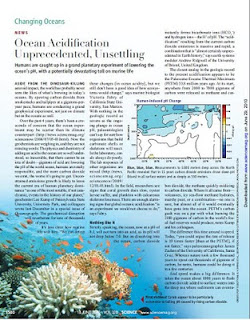From the ocean-themed June issue of
Science comes “
Sea-Level Rise and Its Impact on Coastal Zones“, by Robert J. Nicholls and Anny Cazenave. While sea-level rise will “almost certainly accelerate through the 21st century and beyond because of global warming,” Nicholls and Cazenave state that its magnitude remains uncertain. Small islands as well as the coasts of Africa, India, Southeast Asia, and China are identified as vulnerable areas because of their “dense populations, low elevations, appreciable rates of subsidence, and/or inadequate adaptive capacity.” Nicholls and Cazenave call for more research and analysis into adaptation, which “remains a major uncertainty.”
 “Ocean Acidification: Unprecedented, Unsettling,” by Richard A. Kerr, also appears in the June issue of Science. “Humans are caught up in a grand planetary experiment of lowering the ocean’s pH, with a potentially devastating toll on marine life,” begins Kerr, who aims to convince climate change-focused readers to also look at the world’s oceans. Rising pH levels, caused by ocean waters absorbing higher levels of carbon dioxide, are damaging shelled creatures, coral, and the organisms that rely on them for sustenance (which includes people, especially coastal populations dependent on the oceans for protein). An Australian survey recently found that calcification in the Great Barrier Reef had declined 14.2 percent since 1990 – a severe decline that has not been matched in the last 400 years. Kerr claims that “aside from the dinosaur-killing asteroid impact, the world has probably never seen the likes of what’s brewing in today’s oceans.”
“Ocean Acidification: Unprecedented, Unsettling,” by Richard A. Kerr, also appears in the June issue of Science. “Humans are caught up in a grand planetary experiment of lowering the ocean’s pH, with a potentially devastating toll on marine life,” begins Kerr, who aims to convince climate change-focused readers to also look at the world’s oceans. Rising pH levels, caused by ocean waters absorbing higher levels of carbon dioxide, are damaging shelled creatures, coral, and the organisms that rely on them for sustenance (which includes people, especially coastal populations dependent on the oceans for protein). An Australian survey recently found that calcification in the Great Barrier Reef had declined 14.2 percent since 1990 – a severe decline that has not been matched in the last 400 years. Kerr claims that “aside from the dinosaur-killing asteroid impact, the world has probably never seen the likes of what’s brewing in today’s oceans.”
 “Ocean Acidification: Unprecedented, Unsettling,” by Richard A. Kerr, also appears in the June issue of Science. “Humans are caught up in a grand planetary experiment of lowering the ocean’s pH, with a potentially devastating toll on marine life,” begins Kerr, who aims to convince climate change-focused readers to also look at the world’s oceans. Rising pH levels, caused by ocean waters absorbing higher levels of carbon dioxide, are damaging shelled creatures, coral, and the organisms that rely on them for sustenance (which includes people, especially coastal populations dependent on the oceans for protein). An Australian survey recently found that calcification in the Great Barrier Reef had declined 14.2 percent since 1990 – a severe decline that has not been matched in the last 400 years. Kerr claims that “aside from the dinosaur-killing asteroid impact, the world has probably never seen the likes of what’s brewing in today’s oceans.”Topics: biodiversity, climate change, food security, natural resources, oceans, Reading Radar, water
“Ocean Acidification: Unprecedented, Unsettling,” by Richard A. Kerr, also appears in the June issue of Science. “Humans are caught up in a grand planetary experiment of lowering the ocean’s pH, with a potentially devastating toll on marine life,” begins Kerr, who aims to convince climate change-focused readers to also look at the world’s oceans. Rising pH levels, caused by ocean waters absorbing higher levels of carbon dioxide, are damaging shelled creatures, coral, and the organisms that rely on them for sustenance (which includes people, especially coastal populations dependent on the oceans for protein). An Australian survey recently found that calcification in the Great Barrier Reef had declined 14.2 percent since 1990 – a severe decline that has not been matched in the last 400 years. Kerr claims that “aside from the dinosaur-killing asteroid impact, the world has probably never seen the likes of what’s brewing in today’s oceans.”Topics: biodiversity, climate change, food security, natural resources, oceans, Reading Radar, water A Publication of the Stimson Center.
A Publication of the Stimson Center.





